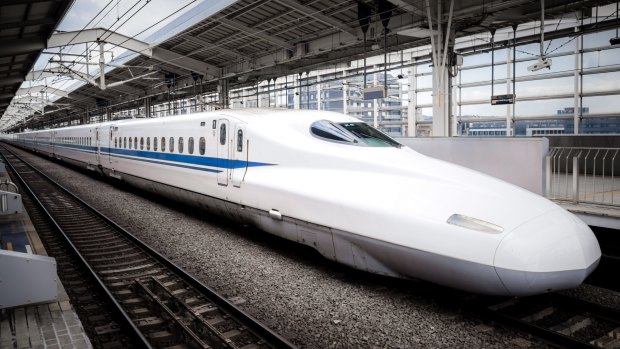This was published 2 years ago
Train review: Hamamatsu to Tokyo on the JR Tokaido-Sanyo shinkansen line

A ride on a Shinkansen is one of life's great pleasures.Credit: iStock
THE JOURNEY
Hamamatsu to Tokyo on the JR Tokaido-Sanyo Shinkansen line, with a scheduled time of one hour and 25 minutes, aboard the Hikari, a 16-car, N700A series limited express train.
THE CLASS

Get a window seat for spectacular views of Mount Fuji.Credit: iStock
There are two classes aboard Japan Rail's Shinkansen, or bullet trains: ordinary class, and Green Car. (There's an even higher tier too, the super-luxe Gran Class, but that's only available on a few services from Tokyo north to Tohoku and Hokkaido.) I'm in Green Car, which the rest of the world could call first class.
CARBON EMISSIONS
2.1 kilograms per passenger. Though there are no flights between these cities, a standard car journey would generate about 40 kilograms of emissions.
BOARDING
Remember: if your Shinkansen is due to depart at 1.43pm, it will depart at 1.43pm. Don't be late. Though don't be early either, because there's no need. You can leave it right to the last moment before strolling into Hamamatsu station, grabbing an "ekiben" – I'll explain later – and arriving on the platform a few minutes before departure. Locate your car's position from the many signs in both Japanese and English, wait in the designated spot on the platform, and you will be on board … at 1.43pm.
THE SEAT
Green Car seats are arranged in a 2-2 formation, as opposed to the ordinary car, which is 2-3. They're wide, plush and comfortable, with power sockets between the seats, and tray tables that swing down from the seat in front (which is miles away). There's free Wi-Fi, though it's patchy and can be tricky to log on to.
BAGGAGE
Shinkansen passengers are allowed two pieces of baggage; for each bag the total length, width and height must not exceed 250 centimetres, length must not exceed 2 metres, and weight must not exceed 30 kilograms. Luggage measuring from 160-250 centimetres total requires prior reservation in an oversize luggage seat (at no extra cost).
FOOD + DRINK
There's no restaurant car aboard the Hikari, just a trolley service selling snacks, drinks and light meals. However, what you really want to do is grab your pre-packed meal at the train station before departure. These are called ekiben – "eki" meaning railway station in Japanese, and "ben" being short for bento – and they're sensational. Choose from ekiben standards such as katsu or sushi, or go for a local specialty, which in Hamamatsu is eel. I've got an unagi-don, or eel rice bowl, and a Yebisu beer, and I couldn't be happier.
ONE MORE THING…
If you're travelling northbound on the Tokaido-Sanyo line, request a seat on the left-hand side of the train. The tracks here skirt the edges of Mount Fuji, and on a clear day you will have incredible views of Japan's most famous peak.
THE VERDICT
A ride on a Shinkansen is one of life's great pleasures. This Hikari service is bang on time (as always), spotlessly clean (as always), easy to find and board, with views of Mount Fuji for a good 15 minutes or so, plus delicious local food, and I'm in the heart of Tokyo within an hour and a half. Doesn't get much better.
OUR RATING OUT OF FIVE
★★★★1/2
The writer travelled as a guest of Hamamatsu and Lake Hamana Tourism Bureau. See global.jr-central.co.jp/en/
Sign up for the Traveller Deals newsletter
Get exclusive travel deals delivered straight to your inbox. Sign up now.